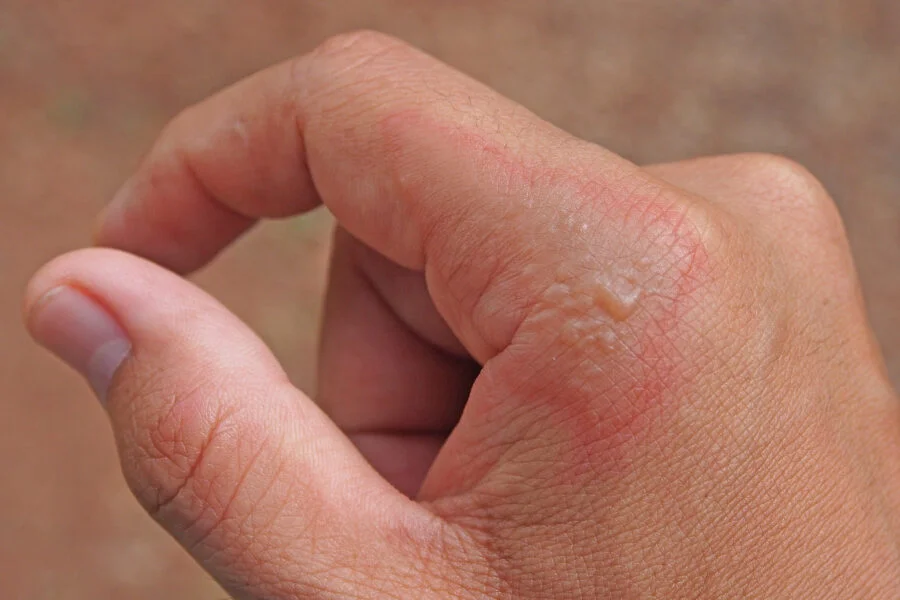From medicine to chemical manufacturing, potassium permanganate has various uses and applications. Its antiseptic properties make it an essential medicine that’s often used to treat wounds and skin conditions, such as dermatitis.
How do you use potassium permanganate?
You can use potassium permanganate in several ways, depending on your requirements. For example, you can use it as medicine if you have dermatitis. Alternatively, if you’re a chemistry student or professional chemist, you can use it in laboratory analysis and as a reagent in synthesising organic compounds.
Medicine
Potassium permanganate has been part of common medicine since the 1800s, and is currently included in the World Health Organisation’s List of Essential Medicines. It can be used to treat a wide variety of skin conditions, including:
- Fungal foot infections
- Impetigo
 Potassium permanganate can be used to treat impetigo
Potassium permanganate can be used to treat impetigo - Pemphigus
- Superficial wounds
- Dermatitis
- Tropical ulcers
When treating skin conditions, potassium permanganate can either be used alone as a solution, or together with other substances.
For example, it’s combined with procaine benzylpenicillin to treat tropical ulcers. It’s particularly effective at treating skin diseases that produce a lot of liquid. A dressing soaked in a solution of potassium permanganate is usually applied to the affected area or it can be used as a bath.
Water treatment
The water treatment industry uses potassium permanganate to remove dissolved iron and hydrogen sulphide from water in wells. These substances cause water to smell, so using potassium permanganate helps to get rid of the ‘aroma’ of rotten eggs. This is done through a ‘Manganese Greensand’ Filter.
Potassium permanganate is also used to control the proliferation of pesky freshwater organisms in water collection and treatment facilities.
Organic compound synthesis
Chemical manufacturing and pharmaceutical companies use potassium permanganate to synthesise organic compounds.
Some of the important organic compounds that are industrially synthesised using potassium permanganate include:
- Ascorbic acid – also known as vitamin C, ascorbic acid is an antioxidant that can be added to drinks
- Chloramphenicol – an antibiotic that’s used to treat various infections, like conjunctivitis and cholera
- Saccharin – an artificial sweetener widely used by diabetic patients
- Isonicotinic acid – an isomer of nicotinic acid (vitamin B3)
- Pyrazinoic acid – used to treat tuberculosis, particularly resistant strains of Mycobacterium tuberculosis
Laboratory analysis
As a strong oxidising agent, potassium permanganate plays a key role in analytical chemistry.
For example, it can be used to quantitatively determine the total amount of organic material that can be oxidised in an aqueous solution. Known as the permanganate value, it’s a useful tool to establish the level of organic pollution in a body of water.
Preserving fruits
Fruits ripen and eventually rot when ethylene is released. However, potassium permanganate can effectively absorb and oxidise ethylene, thus slowing down the ripening process. This makes it possible to extend the shelf life of fruits to up to four weeks without the need for refrigeration.
What does potassium permanganate do?
The various applications of potassium permanganate primarily rely on the compound’s strong oxidising properties. Its ability to oxidise organic substances, including microorganisms, is the reason why it can be used as an antiseptic and disinfectant.
This same property makes it useful in synthesising organic compounds and analysing the quantity of organic compounds in aqueous solutions.
Is potassium permanganate harmful?
At higher concentrations, potassium permanganate can irritate the skin and leave long-lasting stains.
Being a strong oxidising agent means potassium permanganate can remove electrons from a molecule. This breaks the bonds between the constituent atoms, which has harmful effects on living cells.
When ingested, potassium permanganate can damage the upper gastrointestinal tract and may cause bleeding. The lethal dose of potassium permanganate to an adult human is about 10 grams.
Preparing potassium permanganate solution
How you prepare a solution of potassium permanganate depends on the purpose of the solution.
For instance, if you want to make a standardised solution of the substance, you need to weigh the crystals based on the molar mass and dissolve them in a standard proportional volume of water. This would give you the desired concentration.
In the following example, we show how to prepare a 0.02 M aqueous solution of potassium permanganate.
- Dissolve 3.2 grams of potassium permanganate in 1 L of distilled water. This is the equivalent of 2% of the molar mass of the substance, which is 158.034 g/mol
- Heat a water bath for one hour
- Allow the setup to settle for two days
- Filter through glass wool
- Standardise the solution
Can I buy potassium permanganate over the counter?
Pharmacies typically sell potassium permanganate as an over-the-counter remedy for skin conditions. It’s often sold as a fungicidal product in tablet form. It can also be dissolved in water for bathing.
Where to buy potassium permanganate
You can buy potassium permanganate from your local pharmacy. You can also buy it online from a reputable chemical manufacturer, either in bulk or retail volumes. You normally need to be a business to buy it in this way.
Potassium Permanganate MSDS
If you want to read more about potassium permanganate, including how to use and handle it safely, download our Material Safety Data Sheet. You’ll learn about the first aid measures to follow in case of skin contact, eye contact, inhalation, or ingestion.

